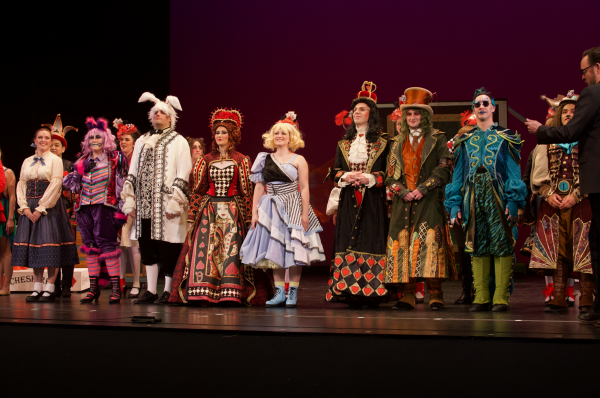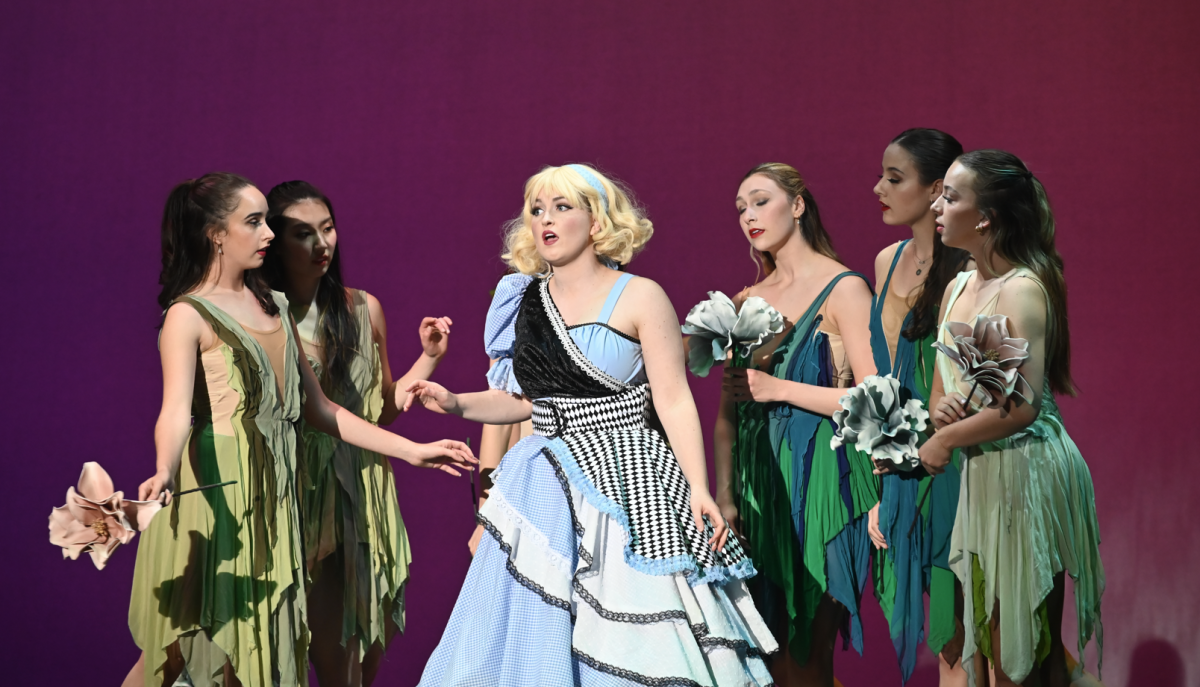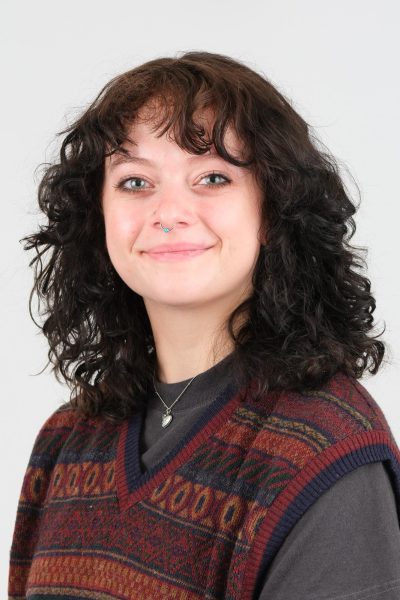When I first walked into the Vocal Arts Center, a small building on the corner of 100 South and University Street, I was immediately greeted by a buzzing energy. To the right of me, in the building’s rehearsal space, a piano was sporadically plucked. Beige bleachers sprinkled with cushions faced an open space mimicking a stage. Cast members filled the bleachers’ seats. Some sat alone with a notebook or laptop, others were grouped together and chatting.
Occasionally I would hear someone sing. In the neighboring room, couches and chairs sat around another piano. Behind them were desks, where one of the production’s directors stood shuffling through papers.
It was Wednesday, April 3, and I was there upon the invitation of Robert Breault, the voice director of opera. I was going to observe U Opera’s rehearsal of “A.L.I.C.E.,” — an adaptation of Lewis Carroll’s “Alice’s Adventures in Wonderland” by Amy Scurria and Zane Corriher. The cast and crew had been rehearsing the piece since the week after spring break, and opening night was a little less than two weeks out.
Breault invited me with the idea of producing a behind-the-scenes look at the opera program’s biggest production of the season — a culmination of two semester’s worth of opera and voice classes. This production also marked the full orchestral debut of “A.L.I.C.E,” and both Scurria and Corriher were involved in the rehearsal process.
“Opera really becomes living because the creating continues through, you know. You get lighting designers involved and stage designers and costume designers and directors,” Scurria explained, and it’s easy to understand what she meant. Through the few rehearsals I observed, I watched “A.L.I.C.E.” gain life. What I saw started with cleaning up some choreography and ended with a beautiful full show.
The Preparation

Learning a new role can be a lengthy, sometimes tedious process. Oftentimes in opera, this process starts with translating a score.
“We usually sing in Italian, German or French, sometimes Russian, sometimes English,” explained Alex Harrelson, who played the White Rabbit and Mad Hatter in “A.L.I.C.E.”
It took him 40 hours to translate “The Barber of Seville” for his role with the Lyrical Opera Theater in February.
Luckily, “A.L.I.C.E.” is in English, so cast members could start learning the music right off the bat. Harrelson likes to start this process by learning a work’s melodies and words separately and combining the two later. Matthew Tang, who played the March Hare, starts by speaking a work’s words and rhythms, only adding in the notes later, and Natalia Turchin Champagne, who played Alice, writes out music and text by hand to memorize them.
For the most part, students are expected to know their parts by the time rehearsals start, Breault explained.
“It’s not fun when you show up to your first staging rehearsal and you don’t know your music,” Tang elaborated.
Rehearsals don’t start with staging right away. Usually, said Tang, they start with music rehearsals, where everyone simply sings through their parts so the cast can hear what everything sounds like together. Then the cast moves to staging — learning how and where their characters will move.
By the time I made it to my first rehearsal, the cast already seemed familiar with their roles. Now it was time to polish things up. After a couple of announcements, Breault shared the scene they would be working on. Almost instantaneously the room got louder. Cast members started singing as they moved props and furniture to their places and the rehearsal pianist started playing pieces of the scene’s music. Within minutes everything and everyone was in their place. The crew spent the rest of rehearsal nailing down the timing of movements.
The next day, rehearsal started with a team-building activity suggested and led by Thia Harris, who played the Duchess. She started by having everyone, including the directors, stand in a circle, hug themselves and acknowledge the commitment and work they’ve all put into the production. They played a quick game before huddling together, hands in and cheering.
The crew spent that rehearsal running through the entire show. The occasional slip-up was ironed out and choreography was adjusted. When they weren’t performing, some cast members sat in the bleachers, cheering and clapping for their castmates as they rehearsed.
“I don’t have words to express the gratitude that we all do support each other,” Champagne reflected. “You always have people who are on the same pace with you and do support you, which is important.”
Breault choked up as he praised the cast’s rehearsal of the show that night.
The Performance
A week later, it was time for dress rehearsals in Kingsbury Hall. In the hour before the curtain call, cast members floated around the dressing rooms in costume. In one room, Robin Farnsley-Becker, the show’s costume designer, put the finishing touches on costume pieces while answering questions from the cast. On the stage, crew members put the finishing touches on set pieces while the cast took turns performing mic checks. Below them, the orchestra warmed up while the conductor, Robert Baldwin, got situated.
Scurria and Corriher arrived and greeted Breault and other members of the production team. Someone delivered a box of scores to the pair so that they could write notes for the cast in them. As they settled into their seats, Scurria and Corriher discussed their admiration for the cast and crew.
“It really comes to life when this whole team comes together, and that’s what I love about it,” Scurria told me in a conversation we had earlier that week.

Corriher likened watching “A.L.I.C.E.” come to life to Dorothy’s adventure in “The Wizard of Oz.”
“It’s like Dorothy stepping out into Oz and it’s the Technicolor and then other people interpret it and put on a performance and it’s like she walks through another door, and there’s even more colors and textures,” Corriher explained.
Eventually, the house lights dimmed and the curtain rose, revealing the cast in full makeup, costume and hair. Watching them perform among completed sets and props with lighting and special effects was like peering into a whole new world. I wasn’t watching the cast members anymore, I was watching their characters adventure through Wonderland.
It wasn’t until I saw everything put together that I think I fully comprehended the work behind the production. Every movement of a light or color change was designed. Every scene change was coordinated and executed by stagehands. Every sound was accounted for and adjusted by sound engineers.
After the rehearsal finished, Breault shared with me that a majority of the production crew volunteered their work and time for a comparatively low cost. It’s their love for the craft and students that motivates them instead, Breault said.
At the end of the rehearsal, the cast rehearsed their bow sequence. The show’s dancers whisked the cast around the stage, giving everyone a moment of recognition. Castmates cheered each other on with whoops and claps as everyone took their bows.
“I am thrilled,” Breault said after the sequence was done. “Clap for yourselves one more time.”




Jordan Thornblad • Apr 23, 2024 at 8:46 pm
Josiii! This pice is so well put together and covered the performance so gracefully! Loved it!
Amy Scurria • Apr 22, 2024 at 12:14 pm
Thank you, Josi, for this beautifully written article. What a gift for Zane and I to have those two weeks commemorated. We are grateful for the time and care you brought to our interviews and the articles you wrote. I have no doubt you will go on to accomplish great things.
Robert Breault • Apr 21, 2024 at 7:42 pm
WOW!!! This is such a fantastic article, Josi!! On behalf of all of us in the College of Fine Arts, THANK YOU!!! You’ve got a wonderful skillset not only as a writer but also as a seer. I’m so glad you were able to “see” so well!!